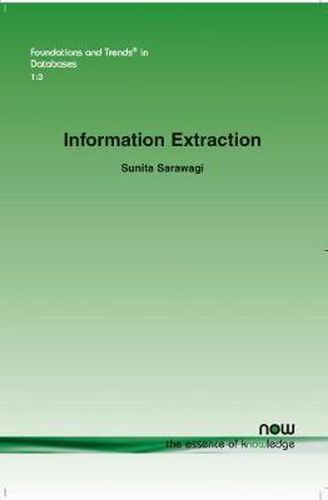Readings Newsletter
Become a Readings Member to make your shopping experience even easier.
Sign in or sign up for free!
You’re not far away from qualifying for FREE standard shipping within Australia
You’ve qualified for FREE standard shipping within Australia
The cart is loading…






This title is printed to order. This book may have been self-published. If so, we cannot guarantee the quality of the content. In the main most books will have gone through the editing process however some may not. We therefore suggest that you be aware of this before ordering this book. If in doubt check either the author or publisher’s details as we are unable to accept any returns unless they are faulty. Please contact us if you have any questions.
Information Extraction deals with the automatic extraction of information from unstructured sources. This field has opened up new avenues for querying, organizing, and analyzing data by drawing upon the clean semantics of structured databases and the abundance of unstructured data. The text surveys over two decades of information extraction research from various communities such as computational linguistics, machine learning, databases and information retrieval. Information Extraction provides a taxonomy of the field along various dimensions derived from the nature of the extraction task, the techniques used for extraction, the variety of input resources exploited, and the type of output produced.
It elaborates on rule-based and statistical methods for entity and relationship extraction. In each case it highlights the different kinds of models for capturing the diversity of clues driving the recognition process and the algorithms for training and efficiently deploying the models. It surveys techniques for optimizing the various steps in an information extraction pipeline, adapting to dynamic data, integrating with existing entities and handling uncertainty in the extraction process.
Information Extraction is an ideal reference for anyone with an interest in the fundamental concepts of this technology. It is also an invaluable resource for those researching, designing or deploying models for extraction.
$9.00 standard shipping within Australia
FREE standard shipping within Australia for orders over $100.00
Express & International shipping calculated at checkout
This title is printed to order. This book may have been self-published. If so, we cannot guarantee the quality of the content. In the main most books will have gone through the editing process however some may not. We therefore suggest that you be aware of this before ordering this book. If in doubt check either the author or publisher’s details as we are unable to accept any returns unless they are faulty. Please contact us if you have any questions.
Information Extraction deals with the automatic extraction of information from unstructured sources. This field has opened up new avenues for querying, organizing, and analyzing data by drawing upon the clean semantics of structured databases and the abundance of unstructured data. The text surveys over two decades of information extraction research from various communities such as computational linguistics, machine learning, databases and information retrieval. Information Extraction provides a taxonomy of the field along various dimensions derived from the nature of the extraction task, the techniques used for extraction, the variety of input resources exploited, and the type of output produced.
It elaborates on rule-based and statistical methods for entity and relationship extraction. In each case it highlights the different kinds of models for capturing the diversity of clues driving the recognition process and the algorithms for training and efficiently deploying the models. It surveys techniques for optimizing the various steps in an information extraction pipeline, adapting to dynamic data, integrating with existing entities and handling uncertainty in the extraction process.
Information Extraction is an ideal reference for anyone with an interest in the fundamental concepts of this technology. It is also an invaluable resource for those researching, designing or deploying models for extraction.